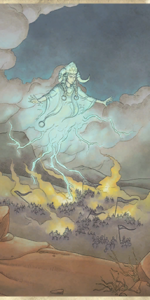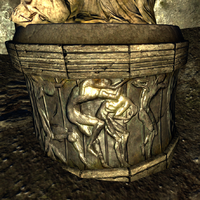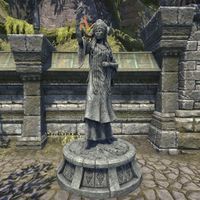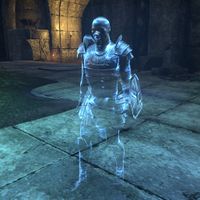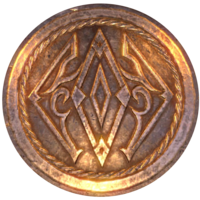Lore:Alessian Slave Rebellion
| To meet our site's higher standard of quality, this article or section may require cleanup. The user who placed this here had the following concern: Needs references and wiki links. To leave a message about the cleanup for this article, please add it to this article's talk page. |
The Alessian Slave Rebellion was a war that lasted from 1E 242[1][2][3] to 1E 243.[4]
Under the leadership of the Slave-Queen Alessia, the enslaved Nede rebelled against their Ayleid overlords. The legendary nomad-warrior Pelinal Whitestrake dealt the final blow when he killed Umaril the Unfeathered in White-Gold Tower. However, Pelinal died along with the Ayleid king, cut into eighths in mockery of the Divines by the Ayleids, who were obsessed with this number.[5]
The victory, while extremely beneficial to the Nede, signaled the slow decline of the Ayleid race's power, which would end around 1E 500, after the Late Ayleid Period.[4]
Summary[edit]
The elves first settled in Tamriel's interior when Topal the Pilot was given the island that would become the Imperial Isle from the native Bird Men in exchange for literacy. The subsequent colonization of what would become Cyrodiil saw numerous elves leaving the Summerset Isles over disagreement over their stringent rules; in particular, the outlawing of Daedra worship. The Ayleid Empire saw its birth in 1E 0 alongside Valenwood when they declared their first High King.[6][7]
Initially the Ayleids worshipped both the Aedric and Daedric gods, though unlike the Chimer they made no distinction between good or bad Daedra. The Ayleid Empire was a decentralized one, with numerous Ayleid city-states allied to one another, and constantly vying for power against one another, with the seat of power being the White-Gold Tower on the Imperial Isle. The Heartland High Elves also enslaved the native Nedic people, and potentially many beastfolk races such as the Minotaurs and Imperial Isle Bird Men. However, a shift in the Ayleid Empire came with the Narfinsel Schism, which was a conflict between the staunch Daedra worshippers, and the staunch Aedra worshipping Barsaebic Ayleids that had its origins in the Late Merethic era. This conflict ended in 1E 198 with the Scouring of Wendelbek, with the Aedra worshipping Barsaebic Elves sent into exile in Argonia, founding the cities that would become Gideon and Stormhold.[8][9][10]
Ayleid society took a turn following this, becoming much more sadistic and hedonistic, with slaves being ritually tortured and sacrificed to Daedric princes in exchange for armies of Daedra and other advantages. It was under this oppression that the slave Alessia prayed to the Eight Divines who granted her their favor. With her slave rebellion successful, she dedicated the city of Sancre Tor to the Aedra. Alongside the heroes Pelinal Whitestrake and Morihaus, Alessia would continue to liberate slaves, and fight the Daedric armies of the Ayleids. Alessia quickly gained allies in several Ayleid city-states unsatisfied with the outlaw of Aedra worship, or looking to opportunistically strike against their fellow Ayleids allied with the Alessians, creating a civil war within the Ayleid Empire. In addition, the First Empire of the Nords, having been previously unable to penetrate deeply into Ayleid territory, swiftly allied with the Alessians.[11][12][13] Alessia hired both Bretons and Nordic warbands as mercenaries with promises of land and trade concessions.[14]
The final battle occurred with the siege of the White-Gold Tower, that culminated in the duel between Pelinal Whitestrake and the demigod Umaril the Unfeathered, ending with Pelinal slain, and Umaril banished to Oblivion. With this battle, the Alessians seized the White-Gold Tower, and the Ayleid Empire was overthrown.[15][13]
Despite this, some other Ayleid kingdoms would persist against the Alessians. The Bravil region was among the last to be conquered by the Alessians.[16] Many surviving Ayleid kingdoms searched for the fabled Wrathstone, believing it to be a mighty enough weapon to defeat the Alessians, but this effort was doomed. An Ayleid army would march into Skyrim and lay siege to Mzulft, as the Dwemer there were thought to possess it, but they only owned one half and had kept it in a separate repository in Kagrenzel.[17] Nevertheless, the Dwemer didn't suffer any serious casualties, and this siege failed.[17] Another half was given to the care of the Ayleid city of Garlas Malatar by Meridia, but the Alessians lay siege to the city and it, too, fell.[18]
Aftermath[edit]
With the Slave Rebellion successful, Alessia founded the Alessian Empire, the second human empire in Tamriel, and the first in the province of Cyrodiil, which would see several others. All former slaves were freed, and allied Ayleid city-states were given vassalage status under the new Alessian Empire. The Nordic Empire gained some territories in the Niben Valley.[citation needed]
The shift of power from mer to men marked the beginning of the Late Ayleid period. Many of the Daedra-worshipping elves fled Cyrodiil. Some tried to integrate into the Barsaebic Ayleids in Argonia, but were rebuffed in retaliation for being exiled from Cyrodiil. Instead, the Ayleid refugees integrated into the elven populations of Valenwood and High Rock.[citation needed]
The Alessian Empire was a cosmopolitan one, featuring early Imperials, Ayleids, Nords and beastfolk among their ranks. Alessia standardized the Imperial Pantheon that fused elements of the Altmeri and Nordic Pantheons, which would become the basis for the Imperial Religion. However, two hundred years later, the fundamentalist Alessian Order arose in vehement opposition to elvish power, and would steadily oppress, exile or slaughter the remaining Ayleids within the Alessian Empire, and may also have contributed to the degradation of Minotaur culture. Eventually, any sightings of Ayleids within the Empire were those of tribal nomads, until the Ayleids vanished altogether.[citation needed]
Upon Alessia's death, Akatosh descended and presented her followers with the Amulet of Kings, vowing that so long as the descendants of the Dragonborn blood sat upon the Ruby Throne in the White-Gold Tower, that the Aedra would protect Mundus from the forces of Oblivion, which saw a drastic shift of power away from the worship of Daedric Princes during the rule of three different incarnations of the Empire, interrupted by invasions from Molag Bal and his Planemeld, and Mehrunes Dagon during the Oblivion Crisis.[citation needed]
Major Battles[edit]
- Duel at the Tor[19]
- Duel at Ninendava
- Duel at Ceya-Tar
- Obliteration of Narlemae and Celediil
- Fall of White-Gold Tower [20]
- Duel of Pelinal and Umaril[21][5][22]
- Siege of Garlas Malatar: Reportedly the city of Garlas Malatar had collapsed prior to Alessian forces coming in to sack it. Either the city was destroyed to deny it to the Alessians, or it fell to internal conflict in response to King Narilmor's increasingly ruthless rule.
- Siege of Bravil: Alessian Forces sieged an Ayleid settlement along the Niben Bay, led by General Teo Bravillius Tasus. The army assaulted it at least four times only to find the Ayleid populations mysteriously vanished. The Ayleids used alteration magic to levitate and breathe water to hide from Alessian forces in the day, and return to slaughter them in the night. Once this was discovered, Tasus easily routed them, and for this victory the settlement was renamed in his honor.
Gallery[edit]
-
A vision of an Alessian knight sacking a Barsaebic Ayleid temple
See Also[edit]
- Alessian Order, responsible for the Ayleid Pogroms
- Sunspire
References[edit]
- ^ Frontier, Conquest — University of Gwylim Press, 3E 344
- ^ Shezarr and the Divines — Faustillus Junius
- ^ Pocket Guide to the Empire, 3rd Edition: The Seat of Sundered Kings: Cyrodiil — Imperial Geographical Society, 3E 432
- ^ a b The Last King of the Ayleids — Herminia Cinna
- ^ a b The Adabal-a — Morihaus
- ^ Pocket Guide to the Empire, 3rd Edition: The Wilds Remain: Valenwood — Imperial Geographical Society, 3E 432
- ^ Before the Ages of Man — Aicantar of Shimerene
- ^ Ayleid Survivals in Valenwood — Cuinur of Cloudrest, 4th Tier Scholar of Tamrielic Minutiae
- ^ Twyllbek Ruins loading screen in ESO
- ^ Stormhold, City of Shadowfen — Cirantille
- ^ Pocket Guide to the Empire, 3rd Edition: The Seat of Sundered Kings: Cyrodiil — Imperial Geographical Society, 3E 432
- ^ Pocket Guide to the Empire, 1st Edition: High Rock — Imperial Geographical Society, 2E 864
- ^ a b Shezarr and the Divines — Faustillus Junius
- ^ The Legendary Sancre Tor — Matera Chapel
- ^ The Last King of the Ayleids — Herminia Cinna
- ^ Daughter of the Niben — Sathyr Longleat
- ^ a b In Pursuit of Mhuvnak
- ^ Frostbitten Journal
- ^ The Song of Pelinal, v 3
- ^ Umbacano's dialogue in Oblivion
- ^ The Song of Pelinal, v 7
- ^ Umaril is Undone — Thadoril
|
|||||||||||||||||||||||||
